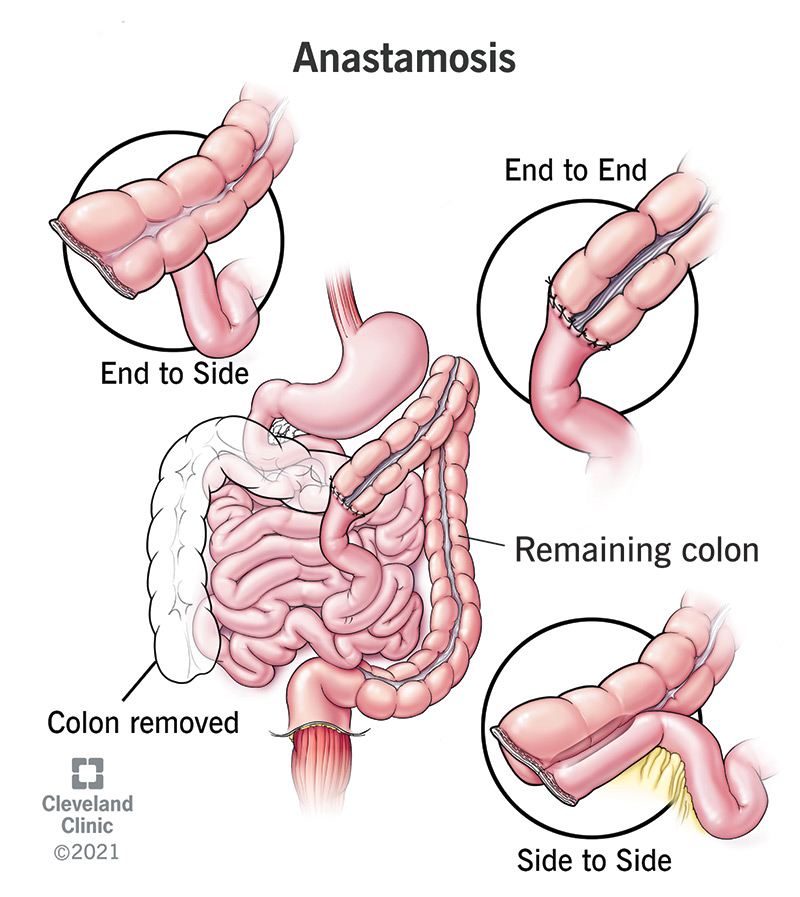Anastomosis in surgery connects two body channels together, such as blood vessels or parts of your intestines. Surgeons create a new anastomosis after removing or bypassing part of a channel, or after removing or replacing an organ that was connected to a channel.
Advertisement
Cleveland Clinic is a non-profit academic medical center. Advertising on our site helps support our mission. We do not endorse non-Cleveland Clinic products or services. Policy
An anastomosis is a connection between two passageways. It may be where two river channels meet, or where plumbing pipes connect under the street. Your body also has many passageways with natural anastomoses. Two major examples of this are your blood vessels (arterial anastomosis) and your gastrointestinal tract, which is your esophagus connected to your stomach, connected to your intestines.
Advertisement
Cleveland Clinic is a non-profit academic medical center. Advertising on our site helps support our mission. We do not endorse non-Cleveland Clinic products or services. Policy
Anastomosis is also an important surgical procedure. Surgeons have to connect body channels together all the time that were previously unconnected. If one of your channels is damaged, they might have to remove the damaged part and reconnect the ends to each other. If one of your body channels has a blockage, they might have to bypass the blockage by creating a new connection and a new pathway.
Intestinal anastomosis is one of the most common types of anastomosis procedures. Your colon is part of your large intestine or large bowel. You might need an anastomosis in your colon after having a colectomy — part of your colon removed. For example, an ileocolonic (or ileocolic) anastomosis reconnects your ileum, the end of your small intestine, to the remaining part of your colon.
Surgical anastomosis most often happens in your circulatory system and your digestive system, and sometimes in your genitourinary tract (your pee pathway). The most common types are vascular and intestinal. A vascular anastomosis joins two blood vessels (arteries or veins). An intestinal or bowel anastomosis reconnects a part of your bowels (your small and large intestines) with another part of your GI tract.
Advertisement

Some common examples include:
Surgeons may reconnect your body channels in a few different ways. They may use these terms:
If your tissues are inflamed due to an infection or disease, your surgeon will want to give them time to heal before attempting anastomosis surgery. This sometimes happens after a bowel resection. When your bowels can’t be reconnected during the same surgery, your surgeon creates an ostomy instead. That means they divert your bowels to a new opening in your abdomen with an ostomy bag attached.
Some people need permanent ostomies, but others will only need temporary ones. These people may have anastomosis surgery at a later time. A temporary ileostomy may be simply reversed or converted to a permanent internal ileal pouch with an ileal pouch-anal anastomosis. A temporary colostomy can be converted to a permanent ileocolic anastomosis. With a successful anastomosis, your surgeon will close your ostomy.
Advertisement
All surgical procedures carry certain standard risks, including:
Complications that are particular to an anastomosis include:
Anastomotic stricture (stenosis). An anastomotic stricture happens when scar tissue at the site of the anastomosis causes the passageway to narrow. Stenosis occurs in 5% of intestinal anastomoses, usually after a few weeks. A stricture can slow down or partially obstruct the passage of food through your GI tract. Stenosis can also occur in the neck of your bladder after prostate surgery, when your urethra is connected to your bladder neck. (This is called bladder neck contracture.) In both cases, healthcare providers can often treat the stricture by dilating it with a balloon, or with tubes. Dilation is a non-surgical procedure.
Anastomotic leak. An anastomotic leak happens when the two ends of your body channel that have been connected together don’t seal completely, and contents from the inside leak out. Anastomotic leaks are reported in about 5% of anastomosis surgeries. Most (75%) are associated with intestinal anastomosis, but they can also occur in vascular anastomosis. Leaks are serious because the channels in our bodies are designed to carry substances that don’t belong in other parts. For example, digestive contents in your intestines contain bacteria that can infect the abdominal cavity if they leak out. A leak may require surgical repair.
Advertisement
Creation of an anastomosis is an important part of many surgical procedures. It’s what makes many of these procedures possible. As a result, it’s also a cornerstone of surgical training. Surgeons have many tools and techniques at their disposal to make your anastomosis successful and to manage complications when they occur. Most succeed without complications. If you do have a leak, early intervention can control it and prevent further complications. If you develop a stricture, it can often be treated with non-surgical methods.
Advertisement
Sometimes you have surgery planned. Other times, it’s an emergency. No matter how you end up in the OR, Cleveland Clinic’s general surgery team is here for you.

Last reviewed on 08/09/2022.
Learn more about the Health Library and our editorial process.